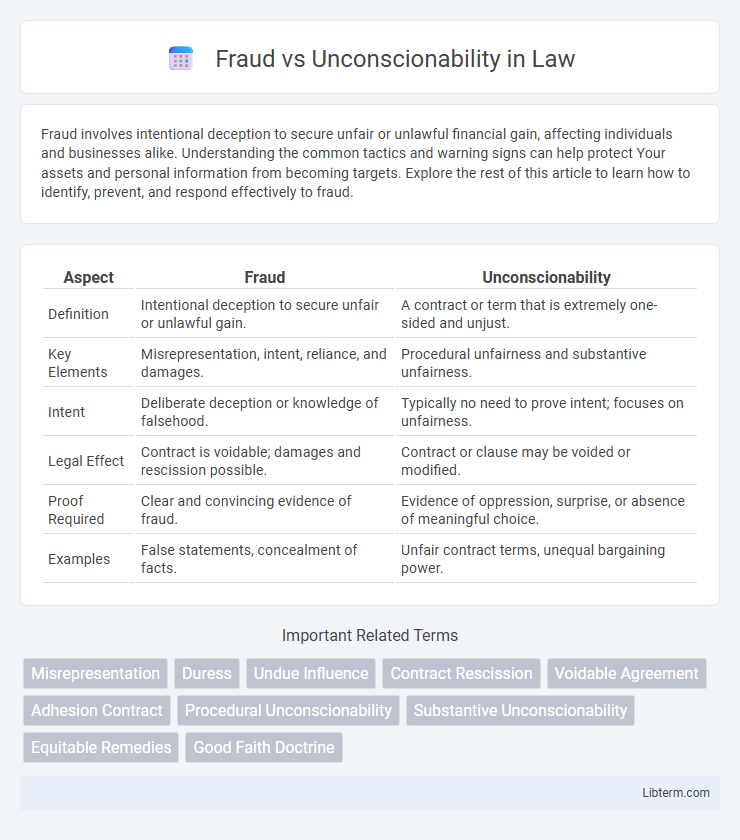Fraud involves intentional deception to secure unfair or unlawful financial gain, affecting individuals and businesses alike. Understanding the common tactics and warning signs can help protect Your assets and personal information from becoming targets. Explore the rest of this article to learn how to identify, prevent, and respond effectively to fraud.
Table of Comparison
| Aspect | Fraud | Unconscionability |
|---|---|---|
| Definition | Intentional deception to secure unfair or unlawful gain. | A contract or term that is extremely one-sided and unjust. |
| Key Elements | Misrepresentation, intent, reliance, and damages. | Procedural unfairness and substantive unfairness. |
| Intent | Deliberate deception or knowledge of falsehood. | Typically no need to prove intent; focuses on unfairness. |
| Legal Effect | Contract is voidable; damages and rescission possible. | Contract or clause may be voided or modified. |
| Proof Required | Clear and convincing evidence of fraud. | Evidence of oppression, surprise, or absence of meaningful choice. |
| Examples | False statements, concealment of facts. | Unfair contract terms, unequal bargaining power. |
Understanding Fraud in Legal Terms
Fraud in legal terms involves intentional deception to secure unfair or unlawful gain, requiring proof of a knowingly false representation, intent to deceive, reliance by the victim, and resulting damages. Unlike unconscionability, which addresses contract fairness and extreme imbalance in bargaining power, fraud centers on deliberate misrepresentation causing harm. Courts rigorously analyze elements such as material misstatements and the victim's reliance to establish fraud and provide appropriate remedies.
Defining Unconscionability in Contracts
Unconscionability in contracts refers to terms so one-sided or unfair that they shock the conscience of the court, often involving inequality in bargaining power or deceptive practices. Courts assess both procedural unconscionability, which examines the circumstances of contract formation, and substantive unconscionability, focusing on the fairness of the contract terms themselves. Unlike fraud, which requires intentional misrepresentation or deceit, unconscionability addresses the overall unfairness and oppression that renders a contract or its clauses unenforceable.
Key Differences Between Fraud and Unconscionability
Fraud involves intentional deception to secure unfair or unlawful gain, demanding proof of misrepresentation, reliance, and resulting harm, whereas unconscionability focuses on the fairness of contract terms, highlighting oppression and unfair surprise without necessarily requiring intent. Fraud addresses the defendant's dishonest conduct aimed at misleading the other party, while unconscionability examines whether the contract's terms are so one-sided that they shock the conscience of the court. Key differences include the necessity of proving intent in fraud and the emphasis on substantive or procedural fairness in unconscionability claims.
Legal Elements Required to Prove Fraud
To prove fraud, the plaintiff must establish a false representation of a material fact made knowingly or with reckless disregard for its truth, intent to induce reliance, actual reliance by the plaintiff, and resulting damages. Each element demands clear and convincing evidence showing the defendant's deceptive intent and the plaintiff's reasonable reliance causing harm. Unlike unconscionability, which centers on unfair contract terms and procedural inequities, fraud requires proof of intentional misrepresentation and its direct impact on the claimant.
Criteria for Determining Unconscionability
Unconscionability is determined by examining factors such as the presence of oppressive terms, significant imbalance in bargaining power, and whether the contract terms shock the conscience of the court. Courts assess procedural unconscionability, focusing on the negotiation process and the fairness of contract formation, alongside substantive unconscionability, which scrutinizes the actual terms for unfairness. Unlike fraud, unconscionability does not require misrepresentation or intent to deceive, but centers on the contract's overall fairness and equity.
Common Examples of Fraud in Transactions
Common examples of fraud in transactions include misrepresenting material facts, such as falsifying financial statements or hiding defects in a product, to induce another party into an agreement. Fraudulent acts often involve intentional deception to secure unfair or unlawful gain, contrasting with unconscionability, which focuses on unfair terms due to unequal bargaining power. Cases of fraud may also involve forgery, false promises, or concealment of critical information that significantly impacts the transaction's validity.
Typical Scenarios of Unconscionable Conduct
Typical scenarios of unconscionable conduct often involve one party exploiting another's vulnerability, such as in cases of grossly unfair contracts with hidden or oppressive terms. For example, consumers with limited bargaining power might face excessively high interest rates or unfair fee structures that a reasonable person would find unacceptable. Courts scrutinize these situations to protect parties from exploitation where consent was not genuinely informed or freely given.
Remedies and Legal Consequences for Fraud
Fraud involves intentional misrepresentation or deceit that leads to damages, allowing courts to award remedies such as rescission, actual damages, and punitive damages to punish misconduct and compensate the victim. Legal consequences for fraud often include nullification of contracts, restitution, and sometimes criminal penalties depending on jurisdiction and severity. Courts prioritize protecting parties from intentional harm and restoring them to their original position before the fraud occurred.
Remedies and Legal Consequences for Unconscionability
Unconscionability remedies primarily involve rescission or reformation of the contract to prevent unfair terms from being enforced, ensuring equitable relief for the disadvantaged party. Courts may refuse to enforce unconscionable clauses or strike specific provisions while upholding the remainder of the agreement, promoting fairness without voiding entire contracts. Unlike fraud, which often leads to damages and punitive remedies, unconscionability focuses on correcting procedural and substantive unfairness to restore contractual balance.
Choosing the Right Legal Claim: Fraud or Unconscionability
Choosing the right legal claim between fraud and unconscionability hinges on the nature of the wrongful act and the evidence available. Fraud requires proving intentional misrepresentation or deceit that caused harm, emphasizing the defendant's knowledge and intent. Unconscionability focuses on unfairness in contract terms or bargaining power, highlighting oppressive or one-sided agreements rather than fraudulent conduct.
Fraud Infographic

 libterm.com
libterm.com